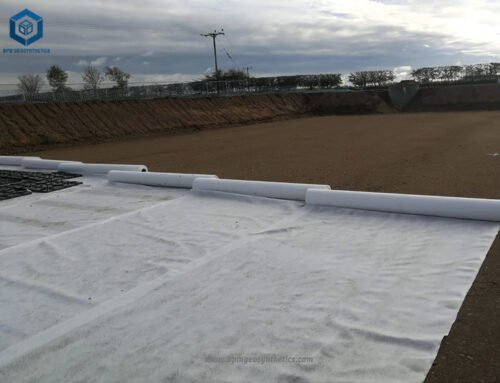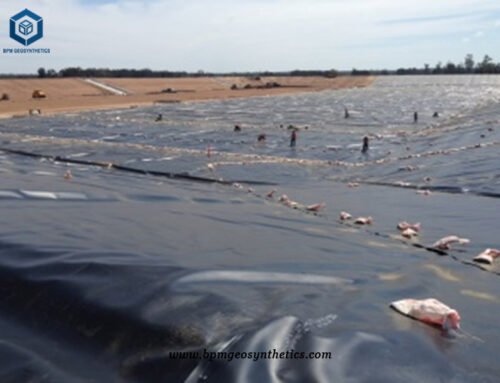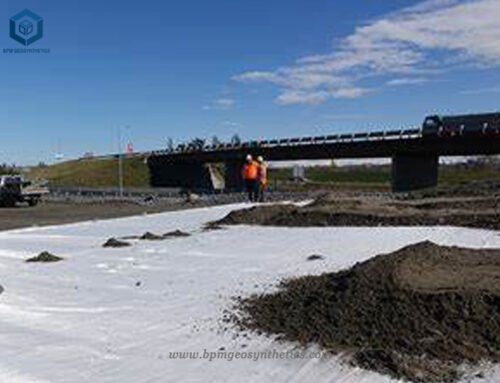PP biaxial geogrid plays a crucial role in enhancing the strength and stability of the road structure. PP biaxial geogrids are typically installed within the road base or subgrade layers. The biaxial geogrids help distribute the load from traffic and prevent the development of cracks and deformations, thereby extending the lifespan of the road. South Africa, being a country with a vast road network, faces various challenges such as heavy traffic loads, expansive soils, and harsh environmental conditions. PP biaxial geogrids address these challenges by providing reinforcement and stabilization to the road infrastructure.
As the leading geosynthetics manfuacturer and supplier, BPM Geosynthetics offers PP biaxial geogrids at best factory price for road reinforcement projects in South Africa.
1. What Is PP Biaxial Geogrid
PP biaxial geogrid is a geosynthetic material made from polypropylene (PP) resin that is used for soil reinforcement and stabilization in civil engineering and construction projects. It has a grid-like structure with intersecting ribs or strands, creating apertures that allow for soil interlocking and load transfer.
The primary purpose of PP biaxial geogrid is to enhance the mechanical properties of soil. It improves the load-bearing capacity, stability, and resistance to deformation of the soil. By installing the geogrid within the soil, it acts as a reinforcement layer, distributing applied loads and minimizing soil settlement or failure.
PP biaxial geogrid is commonly used in a variety of civil engineering applications, including road and railway construction, embankments, retaining walls, slope stabilization, and landfill engineering. It can also be utilized in the construction of reinforced soil structures, such as mechanically stabilized earth (MSE) walls, where the geogrid works in conjunction with compacted soil to provide structural integrity.
2. What Are Beneifts of PP Biaxial Geogrid for Road Reinforcement Project?
PP biaxial geogrids in road reinforcement projects can achieve improved soil stability, increased load-bearing capacity, cost savings, and enhanced long-term performance. These geogrids provide a reliable and sustainable solution for strengthening and extending the lifespan of road infrastructure in South Africa.
2.1 Improved Soil Confinement
PP biaxial geogrids help confine and stabilize the soil within the road structure. They prevent lateral spreading and movement of the soil, reducing the risk of settlement and deformation. This confinement improves the overall integrity and performance of the road.
2.2 Increased Bearing Capacity
By incorporating PP biaxial geogrids, the road’s bearing capacity is significantly enhanced. The geogrids distribute the load from traffic more uniformly, reducing stress concentrations and preventing localized failures. This allows the road to withstand heavier traffic loads and prevents premature pavement distress.
2.4 Reduced Construction Costs
PP biaxial geogrids can reduce construction costs in road reinforcement projects. They provide effective reinforcement without the need for extensive excavation and replacement of poor-quality soil. This saves time, labor, and material costs associated with traditional soil improvement methods.
2.5 Enhanced Long-Term Performance
PP biaxial geogrids offer long-term performance benefits to road structures. They minimize the formation and propagation of cracks, helping to maintain the road’s structural integrity over time. This reduces maintenance needs and extends the service life of the road, resulting in cost savings and improved sustainability.
2.6 Durability and Resistance
PP biaxial geogrids are known for their durability and resistance to environmental factors. They exhibit excellent resistance to moisture, chemicals, and UV radiation, which are particularly important in South Africa’s diverse climatic conditions. This ensures the long-term effectiveness and reliability of the geogrids in road reinforcement projects.
3. What Advantages of PP biaxial Geogrid?
PP plastic geogrids offer multiple benefits in engineering applications. Their high strength, stability, durability, and resistance to various environmental factors make them valuable for a wide range of projects, including retaining walls, foundation reinforcement, slope protection, and roadbed stabilization.
3.1 High Strength and Stability
Plastic geogrids exhibit high strength and minimal creep, making them suitable for use in tall retaining walls and high-grade highways. They can withstand heavy loads and provide stability to the foundation.
3.2 Improved Bearing Capacity
By enhancing the interlocking and occlusion of the reinforced bearing surface, plastic geogrids significantly increase the foundation’s bearing capacity. They effectively restrain lateral soil displacement and enhance overall foundation stability.
3.3 Durability and Convenience
Plastic geogrids offer advantages over traditional grids, including high strength, corrosion resistance, anti-aging properties, large friction coefficient, uniform hole distribution, easy construction, and long service life.
3.4 Seawater Resistance
Plastic geogrids are particularly suitable for deep-sea operations and embankment reinforcement, addressing the challenges posed by long-term seawater erosion. They overcome the issues of low strength, poor corrosion resistance, and short service life associated with gabions made from other materials.
3.5 Construction Damage Prevention
Plastic geogrids can prevent construction damage caused by machine rolling and damage during the construction process. Their robustness and resistance to mechanical stress contribute to a smoother construction operation.
3.6 Roadbed Reinforcement
Plastic geogrids are suitable for reinforcing the roadbeds of highways, railways, and airports, improving stability and load-bearing capacity.
3.7 Foundation Reinforcement
They are well-suited for reinforcing foundations subjected to permanent loads, such as large parking lots and wharf freight yards, ensuring long-term stability and durability.
3.8 Slope Protection
Plastic geogrids are effective in slope protection for railways and highways. They prevent soil erosion and maintain slope integrity.
3.9 Secondary Soil Slope Reinforcement
Plastic geogrids can be used to reinforce soil slopes previously reinforced with one-way tensile geogrids. This secondary reinforcement further strengthens the slope and enhances erosion prevention.
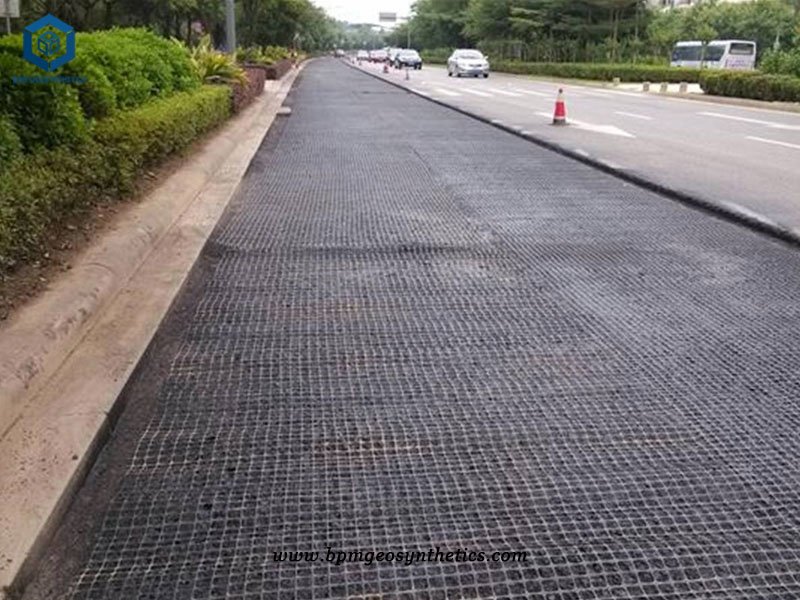

4. Case Study of BPM PP Biaxial Geogrid for Road Reinforcement Project in South Africa
4.1 Project
BPM PP biaxial geogrid Road Reinforcement in South Africa
4.2 Objective
The objective of the project is to reinforce a deteriorating road section that experiences significant settlement and cracking. The goal is to improve the road’s bearing capacity, stability, and longevity, while minimizing maintenance needs and costs.
4.3 Challenges
The road section is prone to differential settlement and cracking due to poor soil conditions and heavy traffic loads. The existing pavement is showing signs of distress, including rutting and surface cracks. Traditional soil improvement methods are deemed costly and time-consuming for this project.
4.4 Solution
The project engineers decide to implement PP biaxial geogrids as a reinforcement solution. The geogrids will provide soil confinement, distribute loads, and enhance the road’s structural integrity.
4.5 Implementation:
- Site Preparation: The road section is surveyed and evaluated to determine the extent of reinforcement required. The existing pavement is assessed for damage and distress patterns.
- Design and Material Selection: The engineers design the reinforcement plan, considering factors such as traffic loads, soil conditions, and geogrid specifications. PP biaxial geogrids with suitable strength and aperture size are selected based on the project requirements.
- Geogrid Installation: Excavation is carried out to the required depth, ensuring proper subgrade preparation. The rolls of PP biaxial geogrids, each measuring 6m*50m, are laid out over the prepared subgrade. The geogrids are unrolled and secured in place using stakes or other appropriate methods.
- Overlying Layers: Once the geogrids are in place, additional layers of granular fill or asphalt are added as per the road design specifications. Compaction is carried out to achieve the desired density and thickness.
- Quality Control: Throughout the installation process, quality control measures are implemented to ensure proper geogrid placement, compaction, and overall construction quality.
4.6 Results and Benefits
- Improved Stability: The PP biaxial geogrids effectively confine the soil and prevent lateral movement, reducing differential settlement and improving road stability.
- Increased Bearing Capacity: The geogrids distribute traffic loads more uniformly, enhancing the road’s bearing capacity and reducing stress concentrations.
- Cracking Prevention: The geogrids control crack formation and propagation, minimizing the occurrence of surface cracks and extending the pavement’s lifespan.
- Cost Savings: The use of PP biaxial geogrids reduces the need for extensive soil excavation and replacement, resulting in cost savings compared to traditional soil improvement methods.
- Long-Term Performance: The durability and resistance of the geogrids ensure their effectiveness over time, contributing to the long-term performance and sustainability of the road infrastructure.
PP biaxial geogrids in this road reinforcement project can successfully improve the stability, bearing capacity, and durability of the road section in City X, South Africa. The use of geogrids provides a cost-effective solution, minimizing settlement issues, reducing maintenance needs, and extending the service life of the road infrastructure.
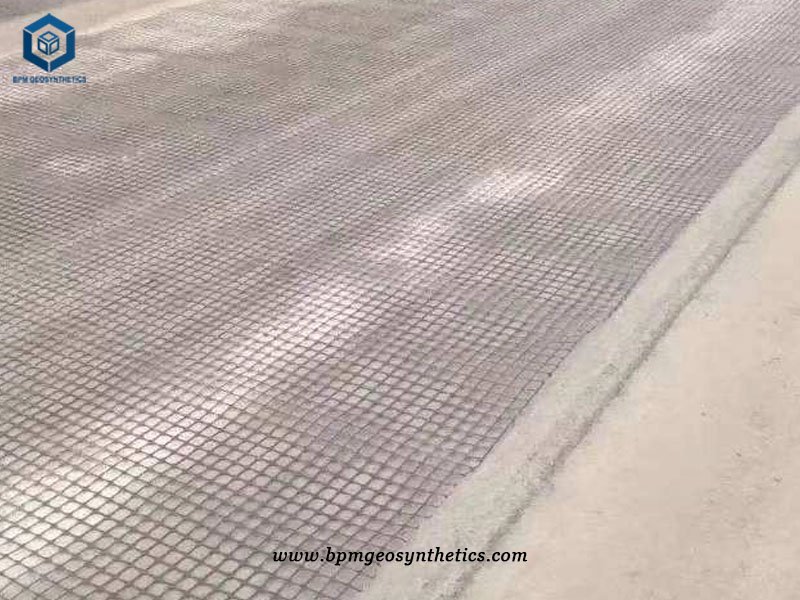
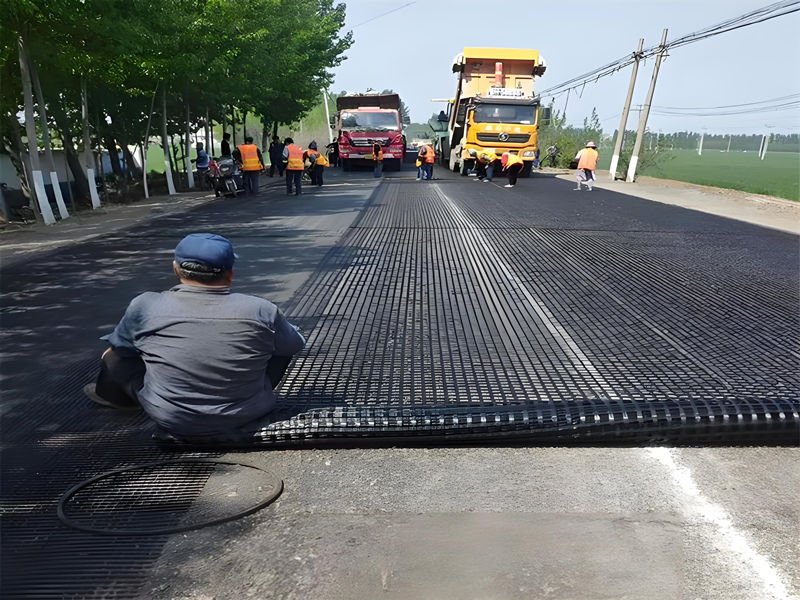
5. How To Install PP Biaixal Geogrid for Road Reinforcement Project?
To install PP biaxial geogrid for a road reinforcement project, the following steps can be followed:
5.1 Construction Site Preparation
Ensure that the construction site is properly prepared by removing spikes, protrusions, and any debris. Compact and level the site to provide a stable base for the geogrid installation.
5.2 Geogrid Laying
Lay the geogrid on the flat and compacted site. The main force direction of the geogrid should be perpendicular to the axis of the embankment. Ensure that the geogrid is laid flat, without wrinkles, and as tightly as possible. Fix the geogrid by inserting nails or using earth-rock weights. The main stress direction of the geogrid should be continuous without joints. If multiple layers of geogrids are required, stagger the layers. Connect the geogrid panels manually by tying and overlapping them, ensuring that the width of the overlap is not less than 10cm. Adjust the straightness of the geogrid as a whole after laying a large area.
5.3 Geogrid Tensioning
Before filling the soil, manually or using equipment, tighten the geogrid again to ensure uniform and adequate tension. This will help the geogrid to be in a state of tension and stress within the soil. The force should be applied uniformly.
5.4 Filler Selection
Select the filler material based on the design requirements. Typically, gravel soil and sand soil are preferred due to their stable mechanical properties and less sensitivity to water content. The particle size of the filler should not exceed 15cm, and its gradation should be controlled to ensure proper compaction.
5.5 Filler Placement and Compaction
After positioning the geogrid, fill the soil and cover it in a timely manner. The exposure time of the geogrid should not exceed 48 hours. The flow operation method of backfilling while laying can be adopted. Start by spreading the filler on both ends, fix the geogrid, and then push the filler to the middle. Roll the filled area first on both sides and then in the middle. Avoid direct contact between the pressure roller and the geogrid during compaction. The compaction should be done in layers, typically 20-30cm thick. Ensure that the compaction meets the design requirements, as it is crucial for the success of the reinforced soil engineering.
5.6 Waterproofing and Drainage
Proper waterproofing and drainage measures should be implemented both inside and outside the reinforced soil structure. Foot protection, anti-scour measures, and filtering and drainage systems should be incorporated. Geotextiles, permeable pipes, or blind ditches can be used as necessary. Ensure that water is drained effectively through proper dredging and prevent any blockages that may pose risks to the stability of the reinforced soil structure.
6. Summary
BPM has been specializing in delivering one stop geosynthetics products and solutions to worldwide customers since its foundation in 2007. BPM had provided many types of effective and state of the art geomembranes, geotextiles, geocells, geosynthetic clay liners (GCLs), drainage boards, geogrids to over 81 countries.
BPM is not only manufacturing best quality geosynthetic products but also providing professional design and installation service. OEM, ODM, custom development and fabrication are also available. If you have any questions or inquiries, please contact us, we will reply as soon as possible.


